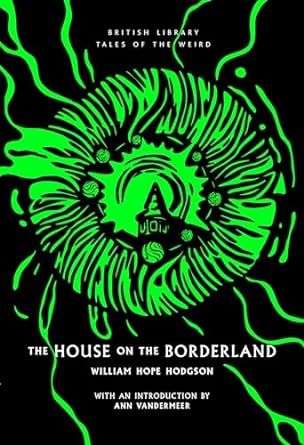
For all things fantasy, horror, and speculative fiction

Review Details
Review type: Book
Title: THE HOUSE ON THE BORDERLAND
Author: William Hope Hodgson
Publisher: British Library Publishing

Reviewed by: Pauline Morgan
Other details: Paperback £9.99
THE HOUSE ON THE BORDERLAND by William Hope Hodgson
Book Review
Pauline Morgan
While the majority of readers are happy to read new books without worrying about the influences that have fed into the prose, there are others who are fascinated by the history and origins of themes and ideas. The British Library series of books is excellent for putting readers back in touch with early works, particularly short stories, from the pioneers of SF, Fantasy and Horror. Novels, such as William Hope Hodgson’s The House on the Borderland, are at the origin of weird fiction. Although there have been writers who specialized in ghost and supernatural stories, this may be the first time strange things happened for which no rational or supernatural explanation has ever been offered. First published in 1908, it influenced such writers as H.P. Lovecraft.
Many of the tropes employed here had been used earlier in fiction and persisted in current fiction because they do the job well. Hodgson himself begins by claiming that he is but the editor of the novel, apparently removing himself from the content. It then becomes a story within a story. Two friends go to a remote part of Ireland on a fishing trip; while exploring, they find the ruin of a house perched precariously over a ravine. Within the ruin, they discover a notebook written by the last person who lived there. Though partly damaged, one of them reads it aloud to the other that night.
The notebook is written by an elderly man who lives in a very old house with his sister. Although there have been a few strange things like noises at night, he has not really been bothered by them for ten years. He starts to keep the journal when events become seriously weird without any apparent trigger. He experiences what could be taken as a hallucination. The end of his room seems to dissolve, giving a view of a plane. He is drawn probably as a disembodied spirit into mountains and to a copy, in jade, of his house. This building is ringed by mountains, and there are images of ancient gods.
Some months later, his house is attacked by hordes of swine-like creatures that appear to have come from the ravine. He holds them off, and they disappear before dawn. Later, he discovers an opening on the side of the ravine, which is exposed by a landslip. Thinking this is where the swine creatures have come from, he explores discovering a bottomless pit beneath his house and is nearly swept into it by a flood.
A large section of the narrative is taken up with a spiritual journey through time and space to the centre of the universe. It is possible that Hodgson was familiar with H. G. Wells’ The Time Machine as the swine creatures having an underground lair have similarities with the Morlocks, and Wells’ time traveller visits the end of the world with similar visual effects as Hodgson’s narrator on his trip through time to the end of the universe.
The sense of something frightening and unearthly coming out of nowhere to attack is the kind of thing that H. P. Lovecraft used in some of these works, to the extent of copying (?) the finale of the manuscript.
The House on the Borderland has merit as historical literature but also for its influence on writers who came later.
Tags: British Library PublishingHorrorWilliam Hope Hodgson
Category: Book Review
All reviews
Latest Reviews:
- Shattered Reality . Call of Cthulhu Scenario Anthology
- The Flesh King by Richard Kadrey
- The Haunted Vintage Marjorie Bowen
- Daughters of Nicnevin by Shona Kinsella
- Katabasis by R. F. Kuang
- Opposite World by Elizabeth Anne Martins
- The Mad Butterfly’s Ball Ed by Preston Grassm & Chris Kelso
- House of the Beast by Michelle Wong
- Born of an Iron Storm by Anthony Ryan
- Call of Cthulhu: The Sutra of Pale Leaves 2 – Carcosa Manifest
Review tags:
Action (48) Adventure (69) Angry Robot Books (11) Contemporary Fantasy (14) Fantasy (114) Folklore (10) Gothic Horror (12) Harper Voyager (12) Historical Fantasy (14) Horror (69) Orbit Books (33) Romance (27) Science Fiction (34) Titan Books (35) TorDotCom (12)
Leave a Reply